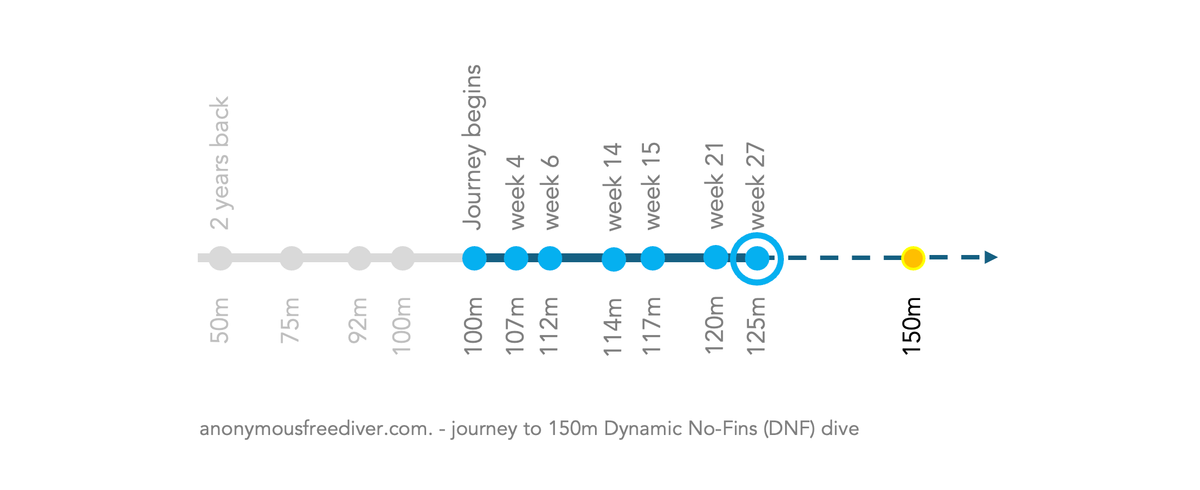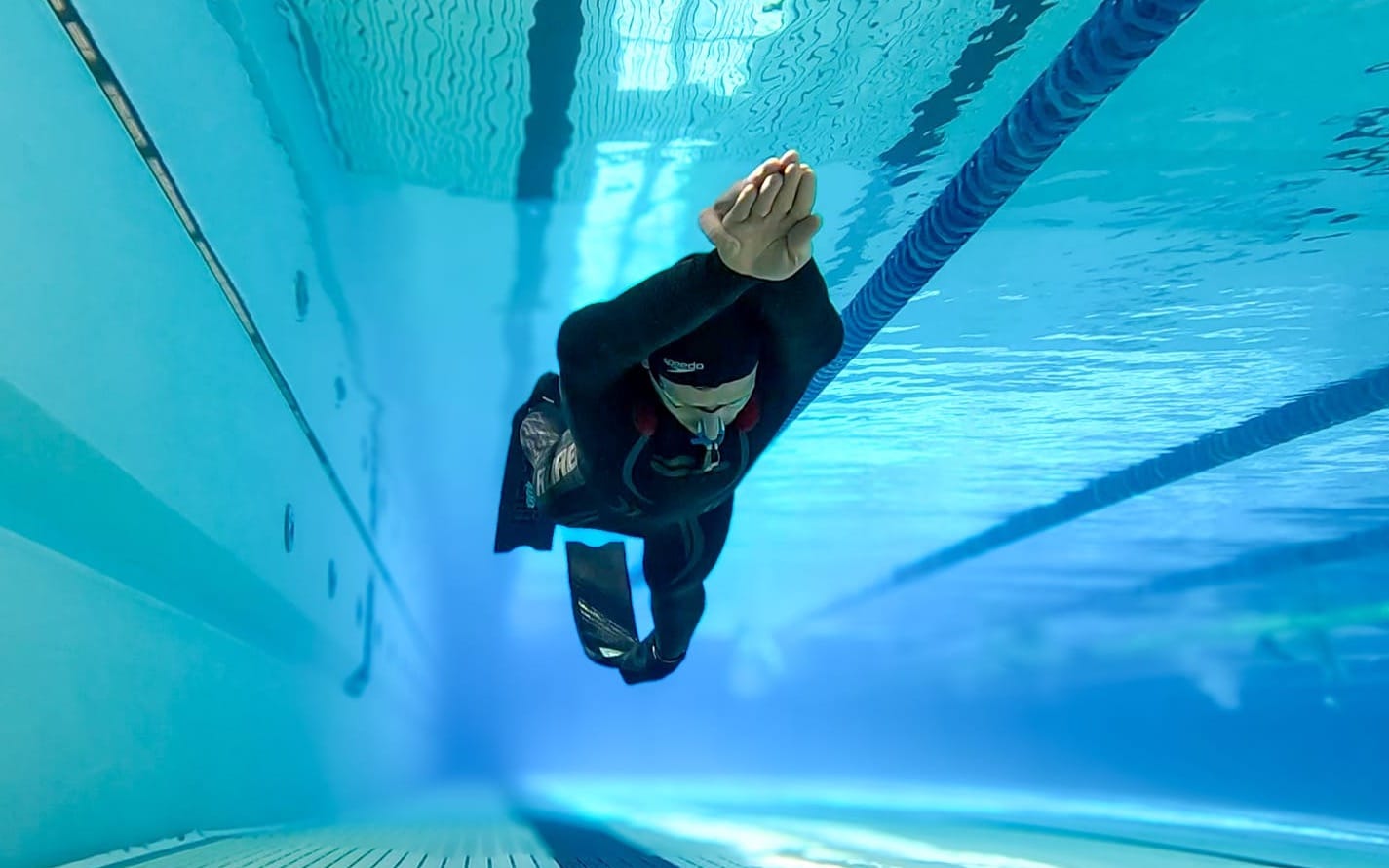Me and my journey to 150m DNF
Anonymous Freediver is an amateur sharing a journey of structured freediving, from unstructured beginnings to ambitious goals like 150m DNF. With 6:00 STA & 125m DNF PBs, this blog offers progress, tips, and insights to inspire fellow divers. It’s not about the name—it’s about the love of the sport!

Who is anonymous freediver?
You may wonder why I chose to blog under the name Anonymous Freediver. It’s not to create mystery, nor is it because I’m a professional hiding behind a pseudonym. Quite the opposite—I’m not an expert, not a professional, and certainly not a coach.
I’m an amateur freediver with over 2 years of experience in freediving, and like many of you, just starting to seriously explore this incredible sport.
My goal is simple: to document my journey, share what I learn, and create a space where other divers can follow along, learn, and feel inspired.
My Personal Bests are:
- 6:00 STA ✌️🎉
- 125m DNF ✌️🎉
- 45m FIM ✌️🎉
- 38m CNF ✌️🎉
I think I have good foundation to proceed further.
Focus on the personal journey, not on the freediver
The choice to remain anonymous reflects that this journey isn’t about me personally. Freediving is a personal journey, one that any diver—maybe you—can embark on. This blog could be written by anyone. It could be your story, your journey, and your own pursuit of improvement in the depths.
What truly matters here is the approach, the progress, the hurdles, and the discoveries that come with working toward a challenging goal.

An Approach to Structured Freediving Training
When I started freediving two years ago, I trained in a very unstructured way. I was learning as I went, doing what felt right, and trying things I picked up from others or from articles here and there. Despite the lack of structure, I managed to reach some respectable milestones: a 100m DNF (Dynamic No Fins) dive and a 5:15 static breath-hold (STA). More recently, I’ve reached 112m DNF and 5:30 STA. But looking back, I see how much was missing in my training. It was, in many ways, the wrong approach—trial and error without much research or planning. Yet it gave me a start.
Three months ago, I made a commitment to approach my freediving goals with a structured plan. I began integrating mixed training workouts, paying more attention to breathing techniques, body conditioning, and other essential elements that extend beyond just time in the pool. Since then, I’ve begun to understand the level of dedication and discipline required to reach my ultimate goal of a 150m DNF dive—a goal that currently feels far away but within reach.
What You Can Expect to Find Here
The purpose of this blog is to share my progress, but it’s also here to provide valuable content for any diver looking to improve. As I train, I’ll share example workouts, training insights, and resources that I find helpful.
While everyone’s path in freediving is unique, I’ll be posting tips, research-based advice, and experiences that you can adapt for your own journey.
Through this blog, I’ll be transparent about my setbacks, breakthroughs, and methods. It’s not a guide or a strict blueprint—because freediving isn’t a one-size-fits-all sport. Each freediver has their own approach, and I encourage you to find yours. But maybe, just maybe, some of the lessons I learn will be useful in your own progress.
This blog documents the journey of an amateur freediver eager to push personal limits and explore what’s possible underwater. I invite you to follow along, learn, and even take away some useful strategies for your own freediving path. My hope is that by sharing my structured training methods, personal experiences, and resources, I can provide you with insights that encourage and empower your own dives.
How I will progress from 100m DNF to 150m DNF
Freediving is a dance between ambition and patience, and my current goal reflects just that - a desire to progress from my 112m DNF personal best to an elusive 150m. This isn’t just a physical challenge; it’s a mental and technical one. It’s not a question of if I’ll reach it, but how I’ll evolve along the way.
Two Focused Sessions a Week
To pursue this goal, I’m committing to at least two freediving sessions weekly. Each session will include dynamic no-fins (DNF) training, with some incorporating static breath holds for added CO₂ tolerance and mental training. I’ll structure my workouts following the guidance in Umberto Pelizzari’s book ("MANUAL OF FREEDIVING UNDERWATER ON A SINGLE BREATH", November 14, 2022, by UMBERTO PELIZZARI).
Any obstacles like sickness or injury I will mitigate with modified training or dry training to avoid longer gaps in the plan.
The Power of Observation
Every dive is an opportunity for learning, and I’ll be recording my training dives for post-session review. Watching myself allows me to identify inefficiencies - whether it’s a suboptimal glide, poor kick rhythm, or unnecessary tension. With these observations, I’ll design drills to improve specific elements. It’s not just about swimming further but swimming better.
The Danger of Overconfidence
Reflecting on my past experiences, I’ve learned that optimism, while motivating, can also lead to frustration if not tempered with realism. When I hit 112m several times, I believed 120m was within easy reach. Yet, I faced unexpected failures at 112m shortly after. Why? Overconfidence and perhaps a subtle loss of respect for the challenge.
This time, I’m embracing a more measured approach. Progressing to 150m isn’t about bold leaps but consistent, small gains. Each session isn’t a race to break records; it’s a brick in the foundation of a stronger, more efficient diver.
Why 150m?
A 150m dynamic no fins (DNF) dive is an impressive benchmark in freediving, placing divers among the top 100 globally in this discipline (as per freedivingranking.com). It represents a high level of skill, efficiency, and mental focus, showcasing mastery of technique and breath control. Setting this goal pushes limits while remaining realistic and achievable with dedicated training.

Will I Reach 150m?
Honestly, I don’t know when or if I’ll hit 150m. What I do know is that the journey itself will make me a better diver - mentally sharper, physically stronger, and technically refined. Freediving has taught me that goals are less about the destination and more about what you become in the process.
The Path Forward
With structured training, critical self-analysis, and a realistic mindset, I’m setting out on this journey.
The road to 150m may be long and uncertain, but it’s one I’m excited to take, one breath at a time.
To see, how I train Dynamic no-fins (DNF) check my training log
So, let’s dive in together—Anonymous Freediver style. It doesn’t matter who I am. What matters is the journey, the progress, and the love of the sport. Let’s see where it takes us.
Disclaimer - why not to hire professional trainer
Choosing not to hire a professional trainer isn’t about rejecting expert guidance - it’s about embarking on a personal journey of self-discovery and growth. By relying on my own initiative and exploring all available resources, I can deepen my understanding of mental and technical aspects of freediving at my own pace. This approach challenges me to identify my strengths and weaknesses, problem-solve independently, and build resilience through trial and error. Ultimately, it’s a way to develop a strong foundation of self-awareness and discipline, which will make any future collaboration with a trainer even more impactful.

